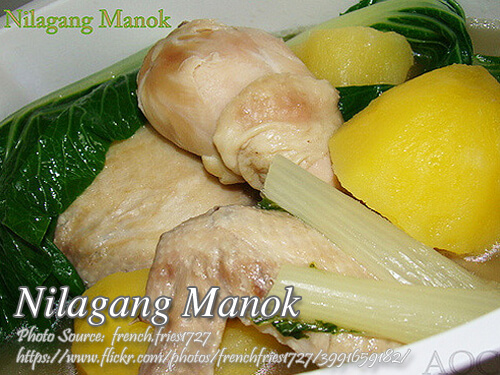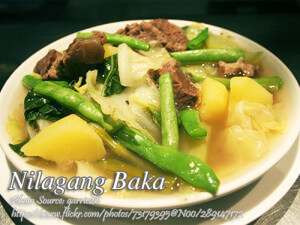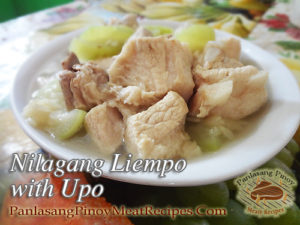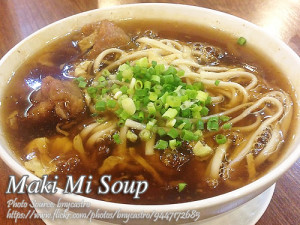Nilagang manok or boiled chicken soup is one of the simplest Filipino recipes by just boiling the chicken and putting all the vegetables and spices in a pot until cooked and presto! you have a tasty nilagang manok dish. In choosing the chicken used in this recipe, it is preferable to choose a native chicken instead of the commercial white leghorn or broilers. It is because the native chicken is a lot more tasty and flavorful. You just need more time in cooking native chicken because it is a bit tougher than the white leghorn or broiler.
Nilagang Manok: A Simple Yet Heartwarming Filipino Classic
Growing up in the heart of my lola’s bustling kitchen, I remember many afternoons filled with the comforting aroma of nilagang manok. The scent would waft through our small home, drawing everyone from their busy routines to gather around the dining table. This humble dish, a staple in many Filipino households, is much more than just boiled chicken soup; it’s a bowl of warm memories and soothing flavors that encapsulate what home tastes like.
Whenever we prepared this simple yet soulful meal, my Uncle Boying would always insist on using manok na bisaya, or native chicken. According to him, the native variety has a depth of flavor that no commercially raised broiler could ever replicate. He had a point, and though it takes a bit longer to tenderize, the payoff in taste is worth every extra minute. The broth is richer, and the chicken meat has a firmer texture, holding up beautifully against the medley of vegetables that make this chicken dish truly satisfying.
The Secret to a Flavorful Broth
The technique for making this Filipino chicken soup may seem straightforward, but the magic lies in how the flavors gently unfold as everything simmers. We always started by boiling the chicken with basic aromatics—onion, salt, and whole peppercorns. My cousin Ana, a culinary student back in Davao, explained to me why this step is crucial. “Low and slow,” she would say, “is the secret to drawing out all those natural flavors.” The slow simmering process ensures that the meat releases its savory essence into the water, creating a broth that’s both clean-tasting and deeply nourishing.
Patience is key. If you’re using native chicken, give it time. Let it simmer gently until the meat is tender and the broth is robustly flavored. If you’re in a hurry and have to use broiler chicken, it’s still delicious, but try to extend the simmer time as much as possible to get a more flavorful soup.
A Hearty Mix of Vegetables
Once the chicken reaches the right tenderness, it’s time to add the vegetables. Each component of nilagang manok brings its own character to the dish, and together, they create a delightful harmony. My mother always favored adding large chunks of potatoes because they absorb the broth beautifully, turning creamy and flavorful. The sweet bananas (saba) are a classic addition that might surprise you if you’re new to this dish, but trust me, they provide a gentle sweetness that balances out the savory notes of the chicken and the earthy flavors of the green beans and cabbage.
Speaking of cabbage, it’s one of my favorite ingredients. Its delicate, leafy texture soaks up the broth, and when cooked just right, it provides a satisfying bite. Then there’s pechay, or bok choy, a leafy green that adds freshness and a hint of bitterness. My brother, Miguel, often swore that pechay was the best part and would always ask for an extra helping. “The greens are good for the soul,” he would joke, as he piled them onto his plate.
Why This Dish Stands the Test of Time
Nilagang manok isn’t just a recipe; it’s a tradition. Each time I make this dish, I’m reminded of the stories shared over bowls of steaming soup and the laughter that echoes in our family gatherings. There’s a timelessness to this dish, perhaps because it’s rooted in simplicity and tradition. Filipinos have been making this dish for generations, and its origins are as humble as the ingredients themselves. Historically, it was a meal designed to stretch whatever ingredients were on hand, transforming basic staples into something heartwarming and filling.
The nutritional benefits also make this dish a favorite among families. The chicken provides a hearty source of protein, while the assortment of vegetables adds vitamins and minerals, perfect for a wholesome meal that feeds the body and soul. In the provinces, you’ll often hear stories of how this was served to invigorate tired farmers coming home after a long day in the fields. It’s a dish meant to replenish and comfort, a true embodiment of Filipino hospitality.
Serving and Enjoying Nilagang Manok
When it comes to serving nilagang manok, the ritual is just as important as the cooking. It’s usually enjoyed with a side of steaming white rice, which soaks up the soup like a sponge, making each bite even more satisfying. My Tita Lita often added a side of patis (fish sauce) mixed with calamansi for a tangy and salty dip, perfect for enhancing the flavor of the tender chicken.
As you sit down to enjoy this dish, don’t forget to savor not just the taste, but the sense of comfort and nostalgia it brings. It’s more than just boiled chicken and vegetables; it’s a reminder of home, a hug in a bowl that never fails to warm the heart.
Whether you’re a seasoned cook or a beginner trying your hand at Filipino cuisine, this recipe is a wonderful place to start. It’s forgiving, easy to make, and endlessly satisfying. And who knows? Maybe it will become a cherished tradition in your own kitchen, just as it has in mine.
How to Cook Nilagang Manok
Ingredients
- 1 kilo chicken cut into desired sizes
- 6 cups water
- 20 pcs whole peppercorns
- 2 tsp. salt
- 1 pc big onion quartered
- 2 pcs potatoes pared and quartered
- 1 head cabbage quartered
- 4 pcs saba bananas halved
- 1 small bundle green onion cut into 2 inch length
- 1/4 kilo green beans stringed and cut into 2 inch lengths
- 1 bunch fresh pechay native
Instructions
How to cook Nilagang Manok:
- Place chicken in a big kettle with water, peppercorns, salt, onion, and bring to a boil.
- Cover and cook until chicken is tender.
- Add potatoes, bananas, cabbage, pechay, green onions and green beans and cook for a few minutes until vegetables are cooked.
- Add season with salt and pepper to taste. Serve hot. Good for 8 persons.
Notes
Cooking Tips:
1. Prepping the Chicken:To ensure tender meat, consider marinating the chicken in calamansi juice or vinegar for at least 30 minutes before cooking. This step helps tenderize the meat and adds a subtle citrusy flavor to the dish. Additionally, removing excess fat and skin from the chicken can result in a lighter and less greasy soup. 2. Enhancing the Broth:
For a richer broth, consider adding a chicken bouillon cube or broth along with water. This can deepen the flavor profile of the soup and make it more savory. Another tip is to skim off any foam or impurities that rise to the surface while the chicken is boiling, which can result in a clearer and cleaner broth. 3. Perfecting the Vegetables:
To maintain the vibrant color and texture of the vegetables, avoid overcooking them. Add the vegetables in stages based on their cooking time, starting with the ones that take longer to cook, such as potatoes and carrots. This ensures that each vegetable is perfectly cooked and retains its distinct flavor and texture in the soup.






Just like nilagang baboy I think this dish is easy to cook.
Hi Ella, actually it is easier to cook than nilagang baboy and requires less time to tenderize the chicken meat.